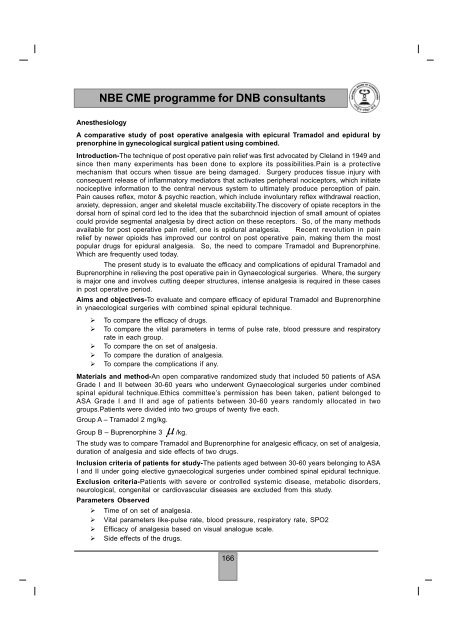NBE CME programme for DNB consultants - National Board Of ...
NBE CME programme for DNB consultants - National Board Of ...
NBE CME programme for DNB consultants - National Board Of ...
Create successful ePaper yourself
Turn your PDF publications into a flip-book with our unique Google optimized e-Paper software.
<strong>NBE</strong> <strong>CME</strong> <strong>programme</strong> <strong>for</strong> <strong>DNB</strong> <strong>consultants</strong>AnesthesiologyA comparative study of post operative analgesia with epicural Tramadol and epidural byprenorphine in gynecological surgical patient using combined.Introduction-The technique of post operative pain relief was first advocated by Cleland in 1949 andsince then many experiments has been done to explore its possibilities.Pain is a protectivemechanism that occurs when tissue are being damaged. Surgery produces tissue injury withconsequent release of inflammatory mediators that activates peripheral nociceptors, which initiatenociceptive in<strong>for</strong>mation to the central nervous system to ultimately produce perception of pain.Pain causes reflex, motor & psychic reaction, which include involuntary reflex withdrawal reaction,anxiety, depression, anger and skeletal muscle excitability.The discovery of opiate receptors in thedorsal horn of spinal cord led to the idea that the subarchnoid injection of small amount of opiatescould provide segmental analgesia by direct action on these receptors. So, of the many methodsavailable <strong>for</strong> post operative pain relief, one is epidural analgesia. Recent revolution in painrelief by newer opioids has improved our control on post operative pain, making them the mostpopular drugs <strong>for</strong> epidural analgesia. So, the need to compare Tramadol and Buprenorphine.Which are frequently used today.The present study is to evaluate the efficacy and complications of epidural Tramadol andBuprenorphine in relieving the post operative pain in Gynaecological surgeries. Where, the surgeryis major one and involves cutting deeper structures, intense analgesia is required in these casesin post operative period.Aims and objectives-To evaluate and compare efficacy of epidural Tramadol and Buprenorphinein ynaecological surgeries with combined spinal epidural technique.‣ To compare the efficacy of drugs.‣ To compare the vital parameters in terms of pulse rate, blood pressure and respiratoryrate in each group.‣ To compare the on set of analgesia.‣ To compare the duration of analgesia.‣ To compare the complications if any.Materials and method-An open comparative randomized study that included 50 patients of ASAGrade I and II between 30-60 years who underwent Gynaecological surgeries under combinedspinal epidural technique.Ethics committee’s permission has been taken, patient belonged toASA Grade I and II and age of patients between 30-60 years randomly allocated in twogroups.Patients were divided into two groups of twenty five each.Group A – Tramadol 2 mg/kg.Group B – Buprenorphine 3 µ /kg.The study was to compare Tramadol and Buprenorphine <strong>for</strong> analgesic efficacy, on set of analgesia,duration of analgesia and side effects of two drugs.Inclusion criteria of patients <strong>for</strong> study-The patients aged between 30-60 years belonging to ASAI and II under going elective gynaecological surgeries under combined spinal epidural technique.Exclusion criteria-Patients with severe or controlled systemic disease, metabolic disorders,neurological, congenital or cardiovascular diseases are excluded from this study.Parameters Observed‣ Time of on set of analgesia.‣ Vital parameters like-pulse rate, blood pressure, respiratory rate, SPO2‣ Efficacy of analgesia based on visual analogue scale.‣ Side effects of the drugs.166
















